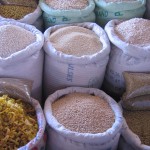 Everyone has seen the proliferation of whole “something” – flour on the shelves. If you’re like most consumers, you may be confused or not care about the meaning of whole wheat flour versus whole grain flour. “Whole” anything sounds healthy! Is there a relationship between the two, a distant cousin, or no relationship at all? We asked Bob Bresnahan this question.
Everyone has seen the proliferation of whole “something” – flour on the shelves. If you’re like most consumers, you may be confused or not care about the meaning of whole wheat flour versus whole grain flour. “Whole” anything sounds healthy! Is there a relationship between the two, a distant cousin, or no relationship at all? We asked Bob Bresnahan this question.
Whole wheat flour means:
- Takes 1.75 bushels of wheat to make a cwt of whole wheat (which is 105lbs of wheat) because the bran is not separated from the flour
- Whole wheat flour may seem it should be cheaper than let’s say an all-purpose flour because it takes fewer bushels of wheat. But you don’t receive a (millfeed/byproduct) credit upon milling
- None of the bran gets blown off when the wheat is ground by the mill
- Higher ash level (most flour has 48-52 percent ash level which indicates the level of bran, which in turn results in darker or whiter flour color. For example, pastry or white cake flour typically has 38 percent ash)
Whole grain flour means:
- Literally means a whole grain – a “whole grain” mixture is added to the flour at the time the flour is mixed for use
- Needs a higher protein with stronger gluten structure to suspend whole grains (or else they will sink to bottom)
- Could be whatever grain – ancient grains or seeds (sunflowers, etc).
Bottom line – whole grain flour is a friend of whole wheat flour. Always remember to refer to the relationship between protein, ash, and moisture levels. We didn’t even mention gluten, but our hunch is that because we love whole grains, which are heavier, it requires more gluten structure to suspend the “bits” so your seeds don’t all fall to the bottom.

